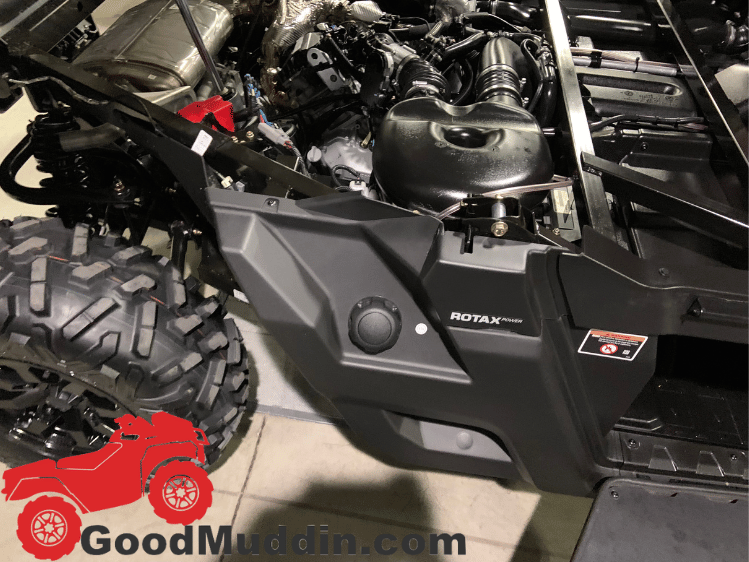The amount of gas an ATV can hold depends on what you have and the manufacturer.
Generally speaking, a standard gas tank can hold anywhere from 2 to 7.5 gallons (7.5 to 28.4 liters) of gas.
For example, a typical sport or utility like the Can-AM OUTLANDER 500 has a fuel capacity of about 5.1 gallons (19.3 liters), whereas a smaller model, such as the Honda TRX 90X, has a fuel tank that holds about 1.7 gallons (6.4 liters). One example of the larger capacity, you have the Sportsman 6×6 BIG BOSS 570 EPS with a 6.75 gallon (25.5 liters) fuel tank.
Always remember to check your specific manual or contact the manufacturer for the most accurate information. This will ensure you’re well-prepared for your rides and adventures. And of course, don’t forget to consider the efficiency of your ATV as well – that is, how far you can ride on a single tank of gas – as this will also impact your refueling needs.
UTV Gas Tank Size
Just like with ATVs, the amount of gas a UTV, often known as a side-by-side, can hold depends on its model and manufacturer.
Generally, a UTV can hold between 7.5 to 10 gallons (28.4 to 37.8 liters) of fuel, though some larger models may have gas tanks that hold up to 14 gallons (53 liters) or more.
For example, a popular model such as the Polaris RZR XP 1000 has a gas capacity of about 9.5 gallons (36 liters), whereas the Can-Am Maverick X3, has a 10.5 gallon (40 liters) gas capacity.
Just like with ATVs, for the most accurate information, it’s always a good idea to consult your UTV’s specific manual or reach out to the manufacturer. Remember, your vehicle’s fuel efficiency – how far it can travel on a single tank of gas – is an important consideration in planning your trips.
ATV & UTV MPG
Miles Per Gallon (MPG) is a common way to calculate how fuel-efficient a vehicle is – that is, how many miles it can travel per gallon of gas used. It’s important to note, though, that fuel efficiency can vary widely depending on several factors, like the vehicle’s make and model, the terrain, the driver’s habits, and more.
On average, ATVs will do 20 to 40 miles per gallon, though this can vary. Smaller models tend to have better fuel efficiency, while larger, heavier ones with more powerful engines will generally consume more fuel, especially if you ride it hard.
Side-by-sides, tend to be less fuel-efficient than ATVs due to their larger size and heavier weight. A normal one might get between 15 to 30 MPG.
Remember, not every 4-wheeler or SXS will have these MPG ratings, some maybe higher or lower.
Fuel Capacity Matters
Knowing how much gas your machine holds is an important factor that many don’t take into consideration. Below, I’ve listed off a few good reasons why the gas capacity matters to better help you in your journey.
- Ride time – The more gas you can carry, the longer you can ride, and the more places you can go.
- Fuel efficiency – Just because you have a larger gas tank doesn’t mean you can go more places, how efficient your quad is matters, and you’ll need to know the gas tank size.
- Weight – The weight of your machine matters when hauling them on trailers, storing them on racks and more. Most people forget to take into consideration the weight, as it does add a good bit more.
- Costs – Everything costs money, and knowing how much gas yours holds can help determine if you can afford to go on that trip.
- Emergencies – Things happen, from tornadoes, floods, and other natural disasters, you may need extra gasoline to power your car, generator or even quad. Knowing how much gas your machine holds, and keeping it full for emergencies, is a good idea. It’s a good idea to do it with other things like boats as they hold more fuel, just make sure to put stabilizer (ad) in them.
- Repairs – Sometimes gasoline goes bad, or you may need to do repairs on your quad, like replacing the fuel pump. Knowing how much gas your quad holds will help you when you need to remove the fuel.
Extending Fuel-Capacity Tips
You can extend the fuel capacity with a portable gas can (ad).
These portable gas cans often have attachments that make it easy to install them. The manufacturers will even have their own type that use their system to attach to your ATV with ease (Can-AM example).
If you’re going camping or going out to hard to reach areas, you can get a trailer for your ATV and carry more fuel that way.
